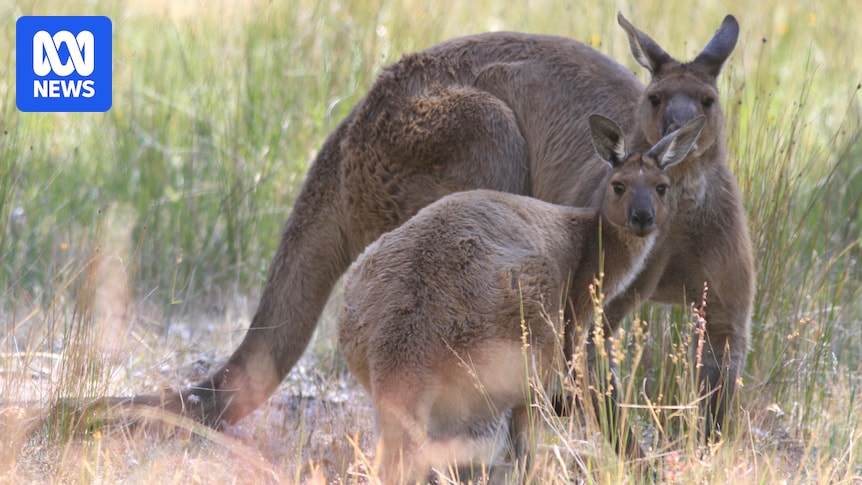Farmers in South Australia are reporting a sharp rise in kangaroo activity, with mobs placing added pressure on pastures, increasing road safety risks, and forcing difficult management decisions.
Ongoing dry conditions across parts of the state have made food and water scarce, pushing kangaroos closer to farmland in search of resources.
Earlier this year, $900,000 of the state government’s multi-million-dollar drought-support package was made available to the Department of Primary Industries and Regions (PIRSA) to help reduce grazing pressure from kangaroos.
PIRSA says kangaroo numbers are high due to the drought that has followed successive good seasons. (ABC News: Gian De Poloni)
The funding provided incentives for kangaroo field processors, and a simpler destruction permit process. But so far farmers in the South East have not noticed any benefits.
Sightings up
Primary producer Nick White, who farms across the Naracoorte and Lucindale region, said kangaroo sightings on his properties have increased dramatically with mobs of up to 140 animals seen at one time.
“Where you used to see none, you’ll now see four or five … other places where you would see four or five you could see 30 or 40 in different spots,” he said.
“It’s pretty hard going.”
Mr White said the added grazing pressure is directly affecting his stocking decisions.
Father and son Graeme and Nick White are concerned about a rise in kangaroo activity across the South East. (ABC South East SA: Elsie Adamo)
“Where you’ve got an extra 40-50-60 kangaroos that’s 60 odd sheep that you can’t have or 15 cattle you can’t feed,” he said.
While the SA government has been actively attempting to eradicate deer with aerial culling, Mr White said some focus needed to be on managing kangaroo populations.
To reduce numbers on his property, Mr White has conducted two lethal culls in the past six months, with little benefit.
“You can shoot 30 and go back a night or two later and see another 40 or 50 in the same spot,” he said.
“People probably don’t want to go down that path because they don’t want to be seen shooting a kangaroo because people in the public don’t like it.”
Balancing act
RSPCA animal welfare advocate Rebekah Eyers said farmers’ concerns were understandable after drought conditions, but culls should only be taken where absolutely necessary.
RSPCA SA animal welfare advocate Rebekah Eyers says most farmers will need to learn to coexist with kangaroo populations. (Supplied: RSPCA SA)
“What we would like to emphasise is that it’s really important still to prioritise the welfare of these native animals,” Dr Eyers said.
The RSPCA does support humane management systems of kangaroos, including ethical lethal management when populations are high and animal welfare becomes a concern.
But without the results of the Department for Environment and Water’s (DEW) latest annual aerial survey, which is due to be released later this year, the RSPCA is unconvinced populations are truly increasing.
The RSPCA instead believes kangaroos have become more visible due to the dry conditions.
Nick White says commercial shooters in the region do not process enough kangaroos to reduce the problem. (ABC News: Matt Roberts)
“I don’t think that anybody could really confidently come out and say that there’s been an explosion in numbers,” Dr Eyers said.
“We would encourage the government and producers to look at effective coexistence strategies.”
Dr Eyers said kangaroos are an Australian icon and the RSPCA was often contacted by “distressed” community members concerned about culling.
“We love our wildlife in South Australia … in general the public, the community, wants to see that kangaroos are managed as humanely as possible,” she said.
Fencing out the problem
While DEW’s aerial survey data may soon offer clarity on population trends, farmers say the pressure from kangaroos is already hard to manage.
Some have turned to non-lethal management tactics in an attempt to control the problem.
Farmer David Miles says while fencing his block works, for larger areas the costs involved make it impracticable. (ABC South East SA: Elsie Adamo)
Primary producer David Miles decided to fence a block near Naracoorte where kangaroos were eating feed meant for cattle.
“Kangaroos have always been a problem, I’m next door to gum plantation and natural vegetation, three sides I’ve got stuff that I can’t control,” he said.
“With stock you can control, rotate or buy and sell, but with kangaroos they’re indiscriminate, and when feed gets short elsewhere they just chase the water and available feed.”
The exclusion fence Mr Miles built was taller and more costly than a standard farm fence, which kangaroos can easily damage.
“It’s probably twice the cost of a normal fence per kilometre,” he said.
Population survey underway
In 2024 the Department for Environment and Water (DEW) estimated more than 200,000 eastern and western grey kangaroos lived within the Lower South East harvest subregion, and the state population level was around 5.2 million.
Kangaroo populations can also be a hazard along roadsides. (Supplied: Macro Group Australia)
A spokesperson for DEW said while the annual aerial survey had been completed, the data would need to be analysed before being released at the end of the year.
“The department encourages the use of non-lethal management methods to manage kangaroo impacts,” the spokesperson said.
“Kangaroos can also be managed commercially through the kangaroo industry by permitted kangaroo field processors.
“Landholders can also apply to manage kangaroos non-commercially via Permits to Destroy Wildlife.”

